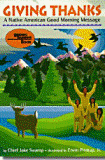Giving Thanks: A Native American Good Morning Message
by Jake Swamp, Erwin Printup (Illustrator) The "good morning message" is a salute to Mother Earth and all her beauty, adapted for children by a chief of the Mohawk nation. This ancient Iroquois message of thanksgiving is traditionally delivered at the beginning of each day. Brightly colored illustrations of landscapes, wildlife, and harvests provide a handsome backdrop. |
Internet Resources
Books
Enrichment Activities
Thankful List
Point out to the children that the Indians gave thanks for many things every day. Ask them to think about all the things they should be thankful for. This includes tangible things such as good food, a comfortable home, pets, and parents, as well as intangible things such as happiness, laughter, and love.
Tell the children to say whatever comes into their heads, and write everything down on the blackboard, without editing. The object of this exercise is to generate a long, diverse list. Use the list in conjunction with the "Thanksgiving Placemats" lesson plan, below. Thanksgiving Placemats
In this lesson, children will use their "thankful lists" to create a colorful and usable placemat that is personally meaningful.
-
Wampanoag Thanksgiving
The "good morning message" in Giving Thanks came from the Iroquois tribe, but giving thanks was a traditional ritual for North American tribes generally. The Indians in the classic Thanksgiving story are the Wampanoags. Ask for volunteers to tell the story of the Pilgrims and Thanksgiving, and write the basic details on the board. These might include arrival on the Mayflower, help from friendly Indians, and a harvest meal including corn and turkey. Ask the students: "From whose point of view do we usually hear the Thanksgiving story?" We may know that the Pilgrims left Europe because of religious persecution, and that they were trying to make a new home in America. But what do we know about the Indians who had lived there for thousands of years? Read the background information aloud to students:
Background Information:
The Indians in the classic Thanksgiving story are the Wampanoags, a tribe that has lived for thousands of years in what is today coastal Massachusetts and Rhode Island. The Wampanoags lived by farming, fishing, hunting, and gathering. In the spring, whole villages moved to the seashore to fish and plant crops such as corn, squash, and beans. Their homes were made of woven mats stretched on wood frames, so it was easy to break camp by taking the mats and leaving the wooden structures behind for their return. In the fall and winter the Wampanoags moved into the forests, where they hunted deer, wolf, bear, beaver, moose, wild turkey, raccoon, otter, and wildcat. From the rivers and lakes they caught fish; in the winter they fished through holes in the ice. The Wampanoags were accustomed to giving thanks for nature's bounty. They thanked the spirits of the game they killed for food, and thanked the Creator for good harvests. Corn was their most valued food, and they believed that it was a gift to them from the Creator. In 1620, a ship carrying European settlers landed off the coast of Massachusetts. The people, who would eventually be called Pilgrims, started a settlement at an abandoned Patuxet Wampanoag village. Some native people helped them through their first difficult year (nearly half of the Pilgrims starved to death) teaching them how to grow and gather native food. When the Pilgrims harvested their first crop, about a year after their arrival, they shared some food with Wampanoags who happened to be visiting. This was the first Thanksgiving. - The Wampanoag had what is called a seasonal diet. Who can explain what that means?
- What did they eat in the summer?
- How were they able to have enough food during the winter months?
- Why was it so easy for them to move from place to place?
- To the Wampanoag, is Thanksgiving just one day of the year?
- What do you think the Pilgrims were thankful for?
Native American Picture Writing
Each Native American tribe had its own spoken language. Explore picture writing with your students.
The Iroquois Constitution
Find a copy of the Iroquois Constitution online and have students read it and then write their impressions of it.
Native American Indian Crafts
Find fun Native American crafts online to help your students learn more about Native American tribes.
Questions for Discussion










